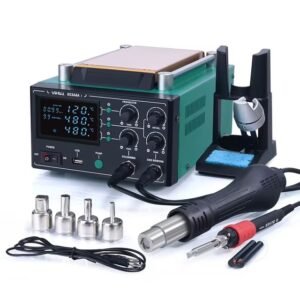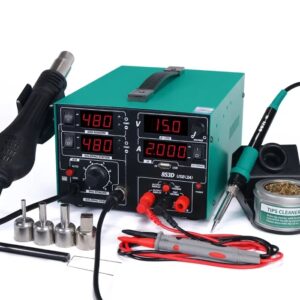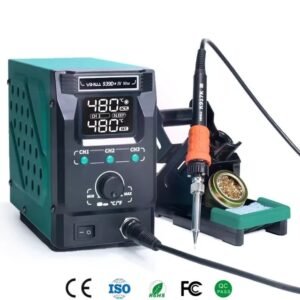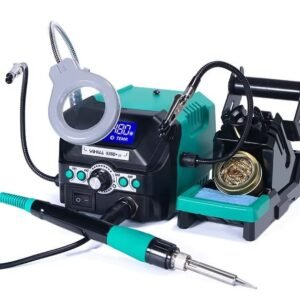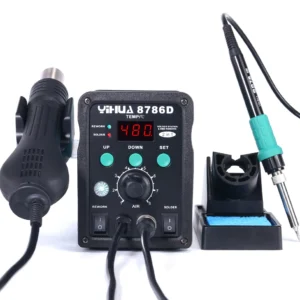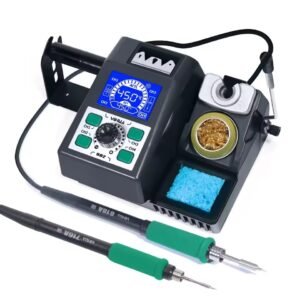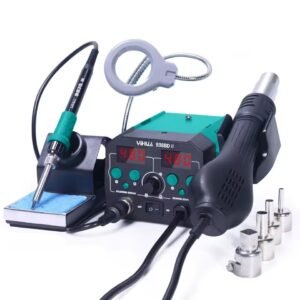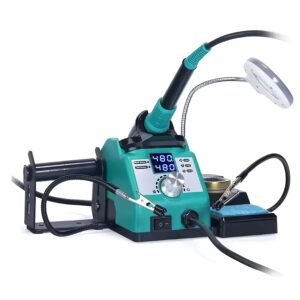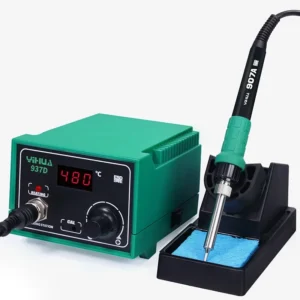Soldering Stations | Easy 60 Day Return
Soldering stations are indispensable tools for anyone who is a hobbyist or electronics enthusiast. At Kunkune, we are proud to introduce you to YIHUA equipment, all products come with a 12-month guarantee and 60 days return/refund.
We offer reliable budget-friendly options for £39.00 937D+ (75W) — a stable everyday soldering station — and £46.00 926LED-IV with built-in LED light and holding hands.Of course, we also offer many other tools, including soldering kits and accessories , and a Hot Air Rework Stations.
Showing all 11 resultsSorted by price: high to low
Showing all 11 resultsSorted by price: high to low
Our Best Soldering Stations – Features & Benefits
Precise Temperature Control for Any Type of Soldering
Each digital soldering station is equipped with accurate temperature control and a control unit featuring a digital display, making it easy to match the heat profile to your chosen solder. The precise temperature settings prevent damage to sensitive components and ensure strong, high-quality solder joints, whether you’re working with lead solder or lead-free solder. Stations provide adjustable temperature ranges from standard soldering temperatures up to 480°C for specialized work.
Quick Solder Tip Change System
Our soldering stations are compatible with a wide selection of tips for different tasks, including T18 and T15 compatible options. From fine conical points for SMD work to larger chisel tips for through-hole applications on PCBs, you’ll find the right solder tip for every job. The quick tip change design at the tip of the iron allows you to switch tasks efficiently without losing heat.
Safety Features in Heavy Duty Equipment
With built-in sleep mode, preset temperature range options, and auto shut-off, these soldering stations protect both the user and the equipment. Even during heavy duty or high power work (up to 150W), safety is maintained. The heating element design prevents overheating conditions during extended use.
Ergonomic & User-Friendly Design
From adjustable temperature dials to comfortable handles, each iron is designed for extended use without fatigue. Lightweight builds and flexible cords make high-precision soldering easier on your workbench. The balanced design ensures comfort even during demanding tasks.
Energy Efficiency with Digital Display
Our models feature a clear display for monitoring temperature and PID control system for consistent heat delivery with excellent thermal stability. This ensures an optimal temperature profile while saving energy. The ceramic heating technology provides rapid heat-up times and the precise amount of heat needed.
Types of Soldering Iron Stations Available
Analog Stations
Simple soldering stations with analogue control and manual dials, ideal for basic tasks with solder. Popular for straightforward jobs, like the YIHUA 937D+ 75W soldering station, where durability, build quality, and ease of use are priorities.
Digital Soldering Station Options
Perfect for delicate work, a digital soldering station offers precise temperature readings and fine adjustments. Comparable in performance to brands like Hakko FX-888D or Weller, these best soldering stations are preferred by professionals who require accurate, repeatable results. The microprocessor-controlled temperature ensures stability even when working on large ground planes or complex circuitry.
Hot Air Rework Station & Multifunction Equipment
Our multifunction desoldering and soldering stations combine hot air guns, soldering irons, and sometimes even DC power supplies from a single power source into one unit. Models like the YIHUA 8786D or YIHUA 939D+ III EVO handle both desoldering and standard soldering for surface mount and through-hole components, making them a multipurpose choice for repair workshops.
Hot Air Soldering & SMD Work
The hot air rework station functionality includes hot-air nozzles for SMD component removal and installation. The hot air gun feature allows you to melt the solder on multiple pins simultaneously, essential for modern stations working with surface-mount technology. Some stations include vacuum pickup tools and tweezer attachments for non-contact IR heating applications.
Power Soldering & Desoldering Equipment
For circuit specialists soldering station needs, we offer powerful soldering equipment with high wattage ratings. A 60-watt or higher station needs consideration for demanding work. The included soldering iron and optional desoldering gun provide one or more soldering tools connected to the main soldering control system, with soldering tools connected through a stable supply.
Battery Powered Options
Battery-powered irons for portable work—you can find them here.
Choosing the Right Soldering Station
Consider these key factors when selecting the best soldering equipment:
Wattage & Power Requirements
Higher wattage (90W–150W) heats solder faster and maintains stable temperatures, ideal for work at higher temperature settings up to 480°C. The heating element capacity determines how well the soldering station handles demanding joints on printed circuit boards. Lower wattage suits light electronics and delicate SMD tasks. Stations offer varying power levels to match your needs.
Temperature Control & Presets
Being able to change between preset profiles quickly is useful for varying solder types and applications. The unit should offer precise adjustment for both lead-free solder (which requires higher temperature) and traditional lead solder. Temperature control maintains the exact profile needed without risk of overheat.
Solder Tip Compatibility
Models supporting T18 or T15 tips provide a wide selection of configurations. The tip of the iron should match your work—conical tips for precision, chisel tips for standard tasks, and specialized tips for different layouts. Quality tips ensure optimal heat transfer and help you start soldering quickly.
Hot Air Nozzles for Rework Station Use
Essential for SMD hot air work, the hot air gun nozzle options are critical for removing and replacing surface-mount components on circuit board assemblies. Different nozzle sizes accommodate various component footprints, from small SMT parts to larger packages. Stations include interchangeable options for versatile rework capabilities.
Ergonomics & Build Quality
Lightweight handles, balanced heating elements, and a stable unit make long sessions easier. The main soldering tool should feel comfortable, and stations available should include proper stands and holders. Quality build ensures your soldering equipment lasts through years of use.
Using a Soldering Station Effectively
Prepare Your Workbench
Keep your PCB or project secure and well-lit on your workbench. Organize your tools and ensure proper ventilation, especially when using hot air or working with lead-free solder that produces more fumes.
Tin the Tip
Always apply a small amount of solder to the hot tip before use for better heat transfer. This protects the solder tip and ensures optimal thermal connection when creating joints. Regular tinning extends tip life.
Apply Heat Correctly
Heat the joint on the board, not just the solder wire, to create a strong connection. The heating element should transfer heat through the tip to both the component lead and the pad simultaneously. This technique works for both through-hole and surface mount work.
Use the Right Temperature
Avoid damage by matching the profile to your solder type. Lead-free solder typically requires temperatures around 350-400°C, while lead solder melts at lower temperatures. The display helps you monitor and maintain the precise temperature needed for quality joints.
Hot Air Soldering Techniques
When using the hot air gun for SMD work, maintain proper nozzle distance and airflow. The hot-air stream should melt the solder evenly without damaging nearby components. Use the temperature and airflow controls to match the component size and thermal mass.
Desoldering Best Practices
For desoldering tasks, the desoldering gun or sucker removes molten solder efficiently. When working with the rework station, heat the entire component uniformly to melt the solder on all connections before removal. This prevents pad damage and makes component extraction cleaner.
Maintain Your Tools
Regular calibration and cleaning will extend the life of your soldering tool. Clean the solder tip frequently during use, replace worn tips promptly, and verify temperature accuracy periodically. The kit comes with basic maintenance tools to keep your equipment in peak condition.
Best Soldering for Different Applications
For SMD & SMT Work
Soldering stations with fine T18 tips and hot air capabilities handle delicate surface-mount components. The precise control and lower settings prevent heat damage to sensitive parts. Stations provide features like vacuum pickup and tweezer attachments for complete SMT assembly and rework.
For Heavy Duty Applications
High-power soldering stations with 75W or higher wattage tackle demanding joints on large ground planes and complex circuitry. The powerful soldering iron maintains temperature even with sustained heat demand, essential for quality results on multilayer printed circuit boards.
For Circuit Board Repair
Repair work often needs both standard soldering and desoldering capabilities. Soldering stations offer integrated desoldering gun or hot air functionality for complete PCB repair workflows. The ability to quickly melt the solder for component removal, then create new joints, makes repairs efficient.
For Plastic Welding & Specialized Tasks
Some users need a soldering station for plastic welding and other specialized applications. Higher temperature capabilities up to 480°C and specialized tips handle these tasks. The heating element provides the sustained heat needed for melting various materials.
Why Choose YIHUA from Kunkune?
Our YIHUA soldering stations deliver professional-grade performance at an affordable price. Whether you’re working with semiconductors, repairing boards, or carrying out industrial jobs, our stations provide the reliability, accuracy, and quality you need.
With features like PID control systems, variable temperature ranges with digital display, and compatibility with multiple replacement tips including T18 and T15 options, they suit everything from occasional home repairs to daily commercial use. Our wide selection includes both simple soldering stations for beginners and advanced rework station models for professionals.
Performance Comparable to Premium Brands
While premium brands like Hakko (including the popular FX-888D) and Weller set high standards in the industry, YIHUA delivers comparable performance with excellent thermal stability and precise control. Our soldering stations include many of the same features found in high-end circuit specialists soldering stations, with a control system that rivals more expensive options.
Wide Selection of Equipment
From basic 60-watt models to advanced iron systems with one or more soldering tools connected, we offer the best soldering equipment for your station needs. Whether you need a soldering station for simple tasks or a complete hot air rework station with desoldering capabilities, our catalog has options for every type of soldering and budget.
Value & Accessibility
YIHUA soldering stations offer excellent value, making professional technology accessible to newcomers while satisfying experienced technicians. The kit comes with essential accessories to start soldering immediately, and our selection ensures you’ll find tips for different tasks and replacement parts readily available.
FAQs – Frequently Asked Questions
What is a Soldering Station?
A soldering station is a complete system used for soldering electronic components. Stations typically include a soldering iron, temperature control unit with display, heating element, and stand. Unlike a basic iron with just a power source, modern stations provide precise adjustment and safety features.
Why Use a Full Soldering Station Instead of a Single Soldering Iron?
The main reason to use a soldering station instead of a standalone soldering iron is precise temperature control through the control unit. This is crucial for sensitive components that can be damaged by excessive heat. Soldering stations provide more stability, better temperature regulation, and enhanced safety features compared to basic irons. The display lets you monitor exact temperature, ensuring consistent solder joints.
What Types of Stations are On the Market?
There are several main types of soldering stations available:
Analog Soldering Stations – Simple soldering stations with manual temperature control, ideal for standard tasks
Digital Soldering Station – Feature microprocessor control, display, and precise settings for high-precision soldering applications
Hot Air Rework Station – Include hot air gun capabilities for SMD and SMT component work alongside traditional soldering iron functions
Desoldering Stations – Combine main iron with desoldering gun for complete repair capabilities
Multifunction Stations – Offer soldering tools connected to one unit, often including hot-air, standard iron, and power supply
Each type of soldering equipment is suited for different tasks and preferences.
How do I Choose the Right Soldering Station for My Needs?
Consider these factors:
Type of Work – SMD work needs lower wattage and precision, while demanding applications on large ground planes require high power and higher temperature capability
Temperature Requirements – Lead-free solder needs stations that reach 350-400°C, while lead solder melts at lower temperatures. Some applications like plastic welding need up to 480°C
Precision Needs – Delicate work requires digital soldering with exact temperature control and fine conical tips. Heavy duty tasks benefit from powerful soldering stations with ceramic heating elements
Budget – Simple soldering stations with analog control are more affordable and perfect for hobbyists. Digital soldering stations and hot air rework station models offer more features but cost more
Features – Consider if you need hot air soldering, desoldering capabilities, adjustable temperature presets, specific tip compatibility (T18, T15), and build quality
Analog soldering stations are simple to use and more affordable, but digital soldering stations offer superior temperature control and the excellent thermal stability needed for professional soldering applications.
What Wattage Do I Need?
For most electronics work on boards, a 60-watt to 75W soldering station provides enough heat. Heavy duty soldering, large ground planes, and demanding work benefit from high-power soldering stations (90W-150W). SMD and delicate SMT components need less wattage but more precise temperature control. The heating element capacity and ceramic heating design matter as much as raw wattage for maintaining stable temperature.
Can These Stations Handle Lead-Free Solder?
Yes, our best soldering stations are designed to handle both lead solder and lead-free solder. Lead-free solder requires higher temperature (typically 350-400°C vs 300-350°C for lead solder), and our digital equipment provides the precise temperature and thermal stability needed. The control system maintains consistent heat even with the higher melting point of lead-free solder, ensuring quality solder joints.
What Makes a Good Hot Air Rework Station?
A quality hot air rework station should offer adjustable temperature and airflow for the hot air gun, a stable main soldering iron, and various nozzle sizes for different SMD and SMT components. Look for soldering stations that include both hot-air and standard iron capabilities, precise temperature control with display, and the quality to handle regular use. Models like the YIHUA 8786D combine these features with excellent thermal performance for complete rework capabilities.
How Do YIHUA Stations Compare to Hakko and Weller?
While Hakko (like the FX-888D) and Weller are established premium brands, YIHUA soldering stations provide comparable performance in temperature control, build quality, and reliability at more accessible prices. Our soldering stations offer similar features including precise temperature adjustment, compatible T18 and T15 tips, ceramic heating elements, and control systems that rival more expensive options. For many users, YIHUA represents the best soldering station value, delivering professional results without the premium brand cost.


